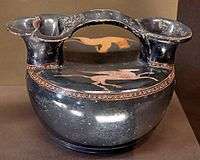Askos (pottery vessel)

An unusually large askos at the Louvre.
| Wikimedia Commons has media related to Askoi. |
- Not to be confused with the placename Askos.
Askos (Ancient Greek ἀσκός "tube"; plural: ἀσκοί - askoi) is the name given in modern terminology to a type of ancient Greek pottery vessel [1] used to pour small quantities of liquids such as oil. It is recognisable from its flat shape and a spout at one or both ends that could also be used as a handle. They were usually painted decoratively like vases and were mainly used for storing oil and refilling oil lamps.
These were extensively traded in and around the Mediterranean. An example of this is UC47602 in the Petrie Museum's collection, which is a black glazed vessel with an almost metallic appearance and was originally produced in Greece (the main production was in Attica) and was excavated in Memphis.
References
- ↑ "Askos - The Classical Art Research Centre". www.beazley.ox.ac.uk. Retrieved 2018-06-14.
External links
This article is issued from
Wikipedia.
The text is licensed under Creative Commons - Attribution - Sharealike.
Additional terms may apply for the media files.